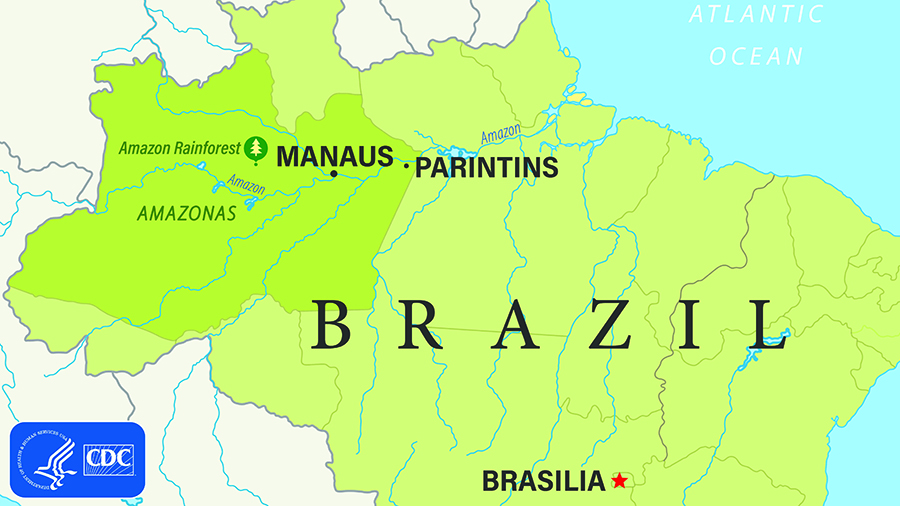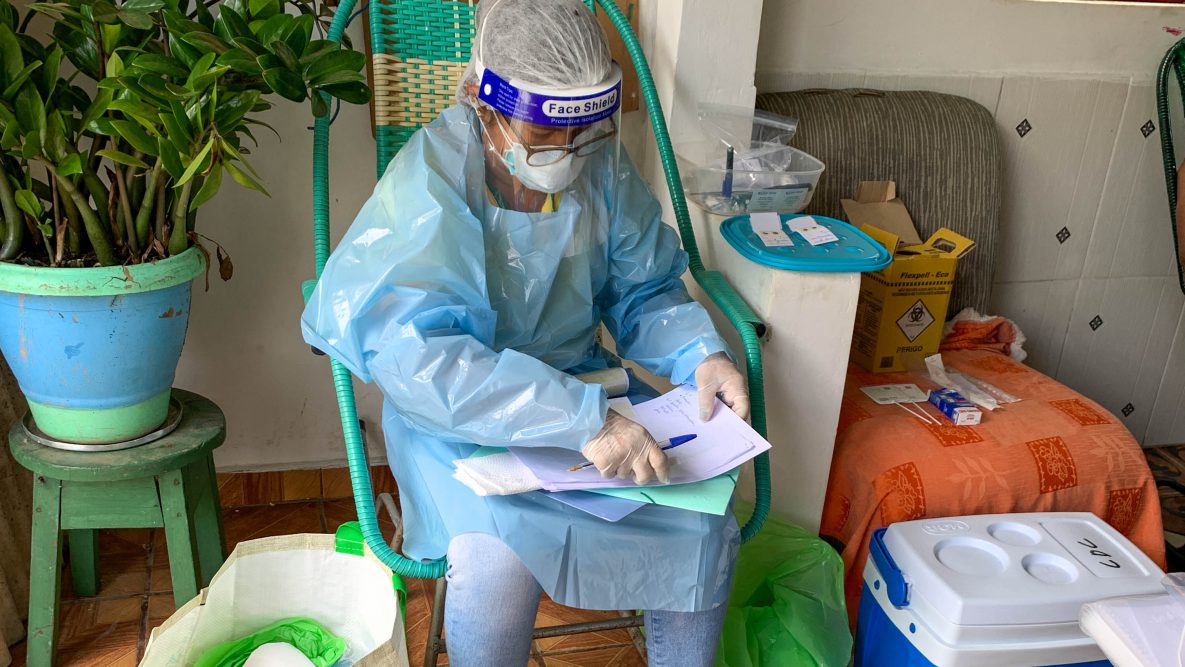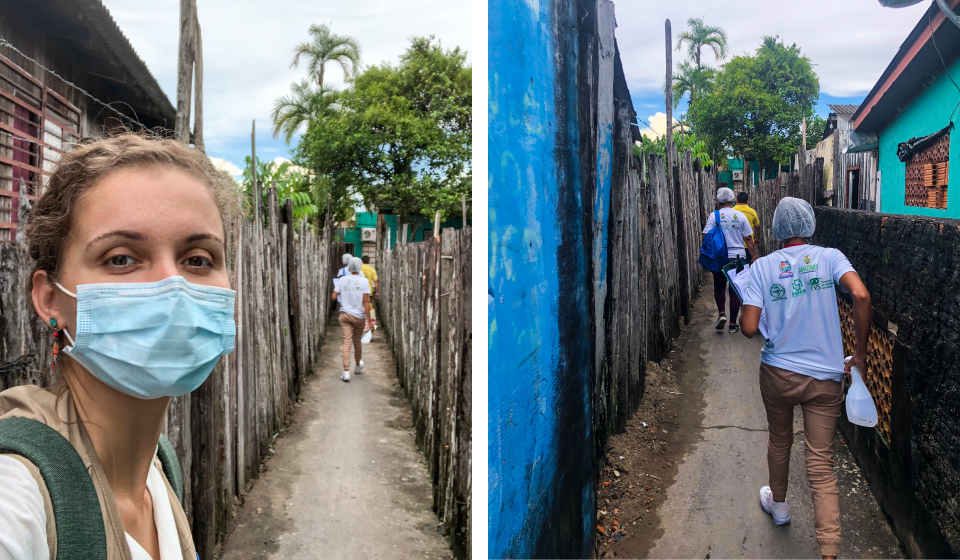Hunting for COVID-19 in the Rain Forest of Brazil

CDC experts went to Brazil in February 2021 to investigate the second COVID-19 wave. They went to a remote community called Parintins along the Amazon River. Here is a riverside community in the Amazon.
Photo by Juliana de Fatima da Silva/CDC
Manaus, BRAZIL — The first wave of COVID-19 overwhelmed the health system in Manaus, the capital of Amazonas, Brazil’s largest state.
The second wave, which started in December 2020, was even worse. By January 2021, there weren’t enough hospital beds, medicine, or oxygen for those who needed it. The situation was dire, according to the governor of Amazonas, Wilson Miranda Lima, who pleaded for urgent medical assistance. “This second wave has hit us with colossal force,” he said in a January 25 letter to the international community, donors, and non-governmental organizations.
Subscribe to CDC’s global health newsletter for more stories like this
CDC sent a team of Portuguese-speaking epidemiologists and laboratory experts to Brazil. Their goal was to learn what was fueling the rapid spread of COVID-19 and conduct a public health investigation.
One of the first to arrive in Manaus, in January 2021, was Roberto Jorge Freire Esteves, MD, an epidemiologist from CDC’S South America Regional Office in Brasilia. The city was in a lockdown phase. “The normally vibrant streets were empty, and people were staying indoors,” he said.
When Atlanta-based Juliana de Fatima da Silva, MD, arrived a few weeks later, on February 20, 2021, the outbreak was out of control and spreading quickly. “The situation was very concerning,” she said.
“Everyone we met had one or multiple stories to share about colleagues or family members who had succumbed to COVID-19. We wanted to understand what role the emerging variant played in that scenario,” she said.
As they prepared for their tasks, the team faced many logistics challenges, including getting personal protective equipment, testing supplies, and a team to a community where they could begin the investigation.
“We had to act fast and overcome several hurdles to carry out the investigation in the middle of this ravaging surge,” says Dr. Freire Esteves. “And we could not have achieved that without the strong support from CDC headquarters and the U.S. Mission to Brazil.”

Drs. Juliana de Fatima da Silva (left) and Roberto Jorge Freire Esteves (right) stand near a U.S. Air Force plane used during a COVID-19 outbreak investigation in remote parts of Brazil.
Photo by Juliana de Fatima da Silva/CDC
After meeting with local health officials, the team planned a journey to the remote city of Parintins, located on an island in the middle of the Amazon rain forest.

Map illustrating cities Manaus and Parintins in Brazil, the Amazonas State, the Amazon river, and the Amazon rain forest
You get there only by plane or a 24-hour boat ride. The team loaded research and testing supplies on a boat that only carried cargo. The U.S. Embassy secured a U.S. Air Force plane to fly the team to and from Parintins, to support the investigation in partnership with the health department.
There the team went to the houses of recently diagnosed people to interview and test their families to find out whether a new strain of coronavirus (referred to as P.1.) was fueling the new outbreak.
In less than 72 hours, CDC and local partners talked to and tested 90 people. Fifty-four tested positive for SARS CoV-2, the virus that causes COVID-19. Of the 45 samples that underwent genetic sequencing, 31 (or 69 percent) had P.1.
“We worked very hard to empower local and state health authorities to take ownership of the samples, data, and process,” said Dr. Freire Esteves. “We really wanted to demonstrate the value of partnering with CDC and this was central to ensuring that. We did not want to be perceived as taking over.”
“This truly was a whole-of-US-Government effort,” said Dr. Juliette Morgan, regional director for CDC’s South America Regional Office in Brasilia. “We needed every bit of support we could find to get people and supplies on the ground in Parintins.”
Residents had limited access to COVID-19 tests, Dr. da Silva said. “They were grateful for the health department and CDC teams who were coming to their homes to offer rapid antigen tests.”

Juliana de Fatima da Silva holds a COVID-19 rapid test. The team took photos of every test result to double check afterwards if the patient was negative or positive. This is one of those tests – it’s negative.
Photo by Juliana de Fatima da Silva/CDC
Engaging CDC experts helped the team solve problems efficiently and effectively. “Working directly with authorities in the state of Amazonas was critical,” said Dr. Freire Esteves. “We are grateful to our colleagues at the State Health Surveillance Foundation and the Municipal Health Department of Parintins for inviting CDC to participate. It really was an all hands on deck situation and without having an epidemiologist on the ground early to see what was happening in Amazonas state, we would not have known how dire the situation was and how CDC’s experts could help local authorities mitigate the spread.”
Analyses of the investigation in Parintins is ongoing, but it is clear that the P.1. variant spread rapidly.





